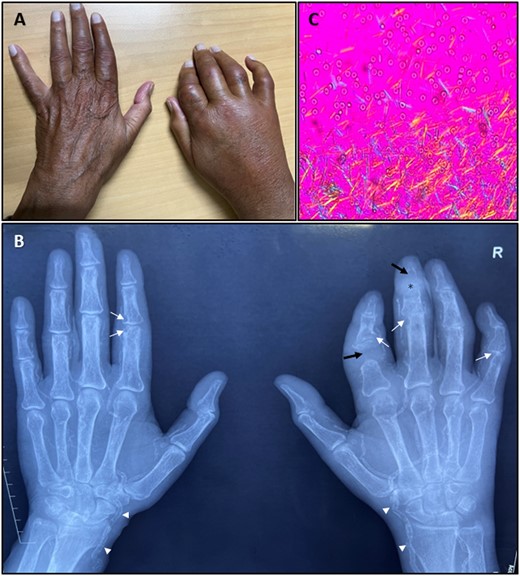-
PDF
- Split View
-
Views
-
Cite
Cite
J Sankar, C B Prasad, J Mathew, V Dhir, S Jain, Arthritis mutilans: an unusual presentation of chronic tophaceous gout, QJM: An International Journal of Medicine, Volume 116, Issue 4, April 2023, Pages 294–295, https://doi.org/10.1093/qjmed/hcac257
Close - Share Icon Share
A 56-year-old male, renal transplant recipient presented with history of acute onset painful swelling of small joints of his right hand. He had history of recurrent similar episodes over past 8 years involving multiple joints of hands and feet, relieved with nonsteroidal anti-inflammatory drugs. On examination, multiple interphalangeal and metacarpophalangeal joints of the right hand were tender with erythematous changes of overlying skin. A short right index finger was also noted with tophaceous deposits (Figure 1A). His investigations revealed raised inflammatory markers, increased uric acid levels (9.8 mg/dl) and a serum creatinine of 2.6 mg/dl. His plain radiograph of hands showed, well-defined ‘punched-out’ erosions with sclerotic margins and overhanging bony edges (Martel’s sign, G sign or rat-bite erosion),1 osteolysis involving phalanx of right index and middle finger (Arthritis mutilans) and calcified tophaceous deposits in right middle finger with extensive vascular calcification (Figure 1B). Aspirate from the tophi revealed numerous negatively birefringent needle-shaped crystals under polarized microscope suggestive of monosodium urate deposition (Figure 1C), thus confirming the diagnosis of chronic polyarticular tophaceous gout. He was started on oral steroids, paracetamol and low-dose allopurinol.

Clinical photograph of both hands (A) showing short right index finger with tophaceous deposits; hand radiograph (B) showing well-defined ‘punched-out’ erosions with sclerotic margins and overhanging bony edges (white arrow), osteolysis of phalanx (black arrow), tophaceous deposits with calcification (asterisk) and vascular calcification (arrow head); and polarized microscopy (C) showing monosodium urate crystals.
Arthritis mutilans is characterized by digital shortening associated with severe osteolysis of peripheral joints, classically described in most severe form of psoriatic arthritis.2 It is rarely reported in gout and the index case highlights the rare manifestation of a common disease.3
Author contributions: J.S., C.B.P., J.M., V.D. and S.J. identified and managed the case; J.S., C.B.P., J.M. and V.D. wrote the manuscript; V.D. and S.J. proof-read and corrected.
Conflict of interest: None declared.
Consent: Written consent has been obtained from the patient for publication.
Data availability: All data relevant to the study are included in the article.



